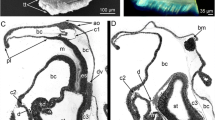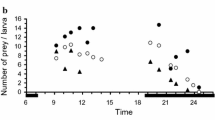Abstract
Merobenthic octopods like Octopus vulgaris undergo a transitional period between the planktonic and benthic phases, known as settlement stage. In this work, three sub-stages (“pre-settlement”, “settlement” and “post-settlement”) have been defined based on morphological, anatomical, and behavioural changes. At the end of the planktonic phase advanced paralarvae are transparent with 65–80 chromatophores, iridophores covering eyes and digestive system, Kölliker organs, circular pupils, ~ 20 suckers per arm (spa), and mantle length (ML) bigger than total length (TL; ML/TL > 60%). The “pre-settlement” sub-stage (ML/TL from 65 to 55%, ~ 20–25 spa) is marked by the onset of clinging reflexes, where the pre-settlers touch the walls and bottom of the tank and start crawling clumsily. Morphologically, they are transparent with increased chromatophores along the arms and iridophores around the eyes and head. During the “settlement” sub-stage (~ 55–48% ML/TL, ~ 25–35 spa) there is an exponential increase of chromatophores in the dorsal area of head and mantle, and the settlers show strong negative phototaxis, crawling for shelter when disturbed. The skin is still transparent but new chromatic cells (leucophores) develop and Kölliker organs are almost lost. During the “post-settlement” sub-stage (~ 48–40% ML/TL, > 35 spa) the post-settlers display very fast and coordinated movements, have horizontal pupils, and develop the “eye-bar”. The chromatic cells keep increasing exponentially, giving a pale appearance to the skin. The beginning of the benthic phase in O. vulgaris juveniles is marked by the presence of skin sculptural components (papillae) and a complex display of chromatic, postural, and cryptic patterns.





Similar content being viewed by others
Data availability
All the data are shown in the manuscript.
References
Boletzky SV (1974) The larvae of cephalopoda: a review. Thalass Jugosl 10(1/2):45–76
Boletzky SV (2003) Biology of early life stages in cephalopod molluscs. Adv Mar Biol 44:143–203
Briceño F, Mascaró M, Rosas C (2010) GLMM-based modelling of growth in juvenile Octopus maya siblings: does growth depend on initial size? ICES J Mar Sci 67(7):1509–1516. https://doi.org/10.1093/icesjms/fsq038
Carrasco JF, Arronte JC, Rodríguez C (2006) Paralarval rearing of the common octopus, Octopus vulgaris (Cuvier). Aquac Res 37:1601–1605. https://doi.org/10.1111/j.1365-2109.2006.01594.x
Dan S, Takasugi A, Iwasaki H, Shibasaki S, Oka M, Hamasaki K (2020) Ontogenic change in the vertical swimming of East Asian common octopus Octopus sinensis paralarvae under different water flow conditions. Aquat Ecol 54:795–881. https://doi.org/10.1007/s10452-020-09777-7
Dan S, Shibasaki S, Takasugi A, Takeshima S, Yamazaki H, Ito A, Hamasaki K (2021) Changes in behavioural patterns from swimming to clinging, shelter utilization and prey preference of East Asian common octopus Octopus sinensis during the settlement process under laboratory conditions. J Exp Mar Biol Ecol 539:151537. https://doi.org/10.1016/j.jembe.2021.151537
Dan S, Kamei Y, Takeshima S, Yamashita K, Hamasaki K (2022) Stepwise changes in morphology during the settlement process in a merobenthic octopus, Octopus sinensis, raised in the laboratory. Invertebr Biol 141(1):1–11. https://doi.org/10.1111/ivb.12358
De Wolf T, Lenzi S, Lenzi F (2011) Paralarval rearing of Octopus vulgaris (Cuvier) in Tuscany, Italy. Aquac Res 42:1406–1414. https://doi.org/10.1111/j.1365-2109.2010.02756.x
Deryckere A, Styfhals R, Vidal EAG, Almansa E, Seuntjens E (2020) A practical staging atlas to study embryonic development of Octopus vulgaris under controlled laboratory conditions. BMC Dev Biol 20:7. https://doi.org/10.1186/s12861-020-00212-6
Fiorito G, Affuso A, Basil J, Cole A, de Girolamo P, D’Angelo L, Ludovic D et al (2015) Guidelines for the care and welfare of cephalopods in research—a consensus based on an initiative by CephRes, FELASA and the Boyd group. Lab Anim 49(2 Suppl):1–90. https://doi.org/10.1177/0023677215580006
Forsythe JW (2004) Accounting for the effect of temperature on squid growth in nature: from hypothesis to practice. Mar Freshw Res 55:331–339
Forsythe JW, Hanlon RT (1988) Effect of temperature on laboratory growth, reproduction and life span of Octopus bimaculoides. Mar Biol 98:369–379
Franco-Santos RM, Iglesias J, Domingues PM, Vidal EAG (2014) Early beak development in Argonauta nodosa and Octopus vulgaris (Cephalopoda: Incirrata) paralarvae suggests adaptation to different feeding mechanisms. Hydrobiologia 725(1):69–83. https://doi.org/10.1007/s10750-013-1721-4
Gleadall IG (2016) Octopus sinensis d’Orbigny, 1841 (Cephalopoda: Octopodidae): valid species name for the commercially valuable East Asian common octopus. Spec Div 21(1):31–42. https://doi.org/10.12782/sd.21.1.031
Hanlon RT (1999) Crypsis, conspicuousness, mimicry and polyphenism as antipredator defences of foraging octopuses on Indo-Pacific coral reefs, with a method of quantifying crypsis from video tapes. Biol J Linn Soc 66(1):1–22. https://doi.org/10.1006/bijl.1998.0264
Ibáñez CM, Peña F, Pardo-Gandarillas MC, Méndez MA, Hernández CE, Poulin E (2014) Evolution of development type in benthic octopuses: holobenthic or pelago-benthic ancestor? Hydrobiologia 725(1):205–214. https://doi.org/10.1007/s10750-013-1518-5
Ibarra-García LE, Mazón-Suástegui JM, Rosas C, Tovar-Ramírez D, Bárcenas-Pazos G, Civera-Cerecedo R, Campa-Córdova AI (2018) Morphological and physiological changes of Octopus bimaculoides: from embryo to juvenile. Aquaculture 497:364–372. https://doi.org/10.1016/j.aquaculture.2018.07.069
Iglesias J, Otero JJ, Moxica C, Fuentes L, Sánchez FJ (2004) The completed life cycle of the octopus (Octopus vulgaris, Cuvier) under culture conditions: paralarval rearing using Artemia and zoeae, and first data on juvenile growth up to 8 months of age. Aquac Int 12:481–487
Itami K, Izawa Y, Maeda S, Nakai K (1963) Notes on the laboratory culture of Octopus larvae. Bull Jpn Soc Sci Res 29(6):514–520
Jackson D, Leys SP, Hinman VF, Woods R, Lavin MF, Degnan BM (2002) Ecological regulation of development: induction of marine invertebrate metamorphosis. Int J Dev Biol 46:679–686
Messenger JB (2001) Cephalopod chromatophores: neurobiology and natural history. Biol Rev 76(4):473–528
Moguel C, Mascaró M, Avila-Poveda OH, Caamal-Monsreal C, Sánchez A, Pascual C, Rosas C (2010) Morphological, physiological and behavioral changes during post-hatching development of Octopus maya (Mollusca: Cephalopoda) with special focus on the digestive system. Aq Bio 9(1):35–48. https://doi.org/10.3354/ab00234
Naef A (1923) Die cephalopoden. Systematik Fauna Flora Golfes Neapel 35:1–863
Nixon M, Mangold K (1996) The early life of Octopus vulgaris (Cephalopoda: Octopodidae) in the plankton and at settlement: a change in lifestyle. J Zool 239(2):301–327
Okumura S, Kurihara A, Iwamoto A, Takeuchi T (2005) Improved survival and growth in Octopus vulgaris paralarvae by feeding large type Artemia and pacific sand eel, Ammodytes personatus: Improved survival and growth of common octopus paralarvae. Aquaculture 244(1–4):147–215. https://doi.org/10.1016/j.aquaculture.2004.11.044
Packard A (1985) Sizes and distribution of chromatophores during post-embryonic development in cephalopods. Vie Et Milieu 35(3/4):285–298
Packard A, Hochberg FR (1977) Skin patterning in Octopus vulgaris and other genera. In: Nixon M, Messenger JB (eds) The biology of cephalopods, Symposia of the zoological society of London, vol 38. Springer, pp 191–231
Packard A, Sanders GD (1971) Body patterns of Octopus vulgaris and maturation of the response to disturbance. Anim Behav 19(4):780–790. https://doi.org/10.1016/S0003-3472(71)80181-1
Pecl GT, Steer MA, Hodgson KE (2004) The role of hatchling size in generating the intrinsic size-at-age variability of cephalopods: extending the forsythe hypothesis. Mar Freshw Res 55:387–394. https://doi.org/10.1071/MF03153
Rees WJ (1950) The distribution of Octopus vulgaris Lamarck in British waters. J Mar Biol Assoc United Kingdom 29(2):361–378. https://doi.org/10.1017/S0025315400055417
Robin JP, Roberts M, Zeidberg L, Bloor I, Rodriguez A, Briceño F, Downey N, Mascaró M, Navarro M, Guerra A, Hofmeister J, Barcellos DD, Lourenço SAP, Roper CFE, Moltschaniwskyj NA, Green CP, Mather J (2014) Transitions during cephalopod life history: the role of habitat, environment, functional morphology and behaviour. Adv Mar Biol 67:361–437. https://doi.org/10.1016/B978-0-12-800287-2.00004-4
Roura Á, Amor M, González ÁF, Guerra Á, Barton ED, Strugnell JM (2019) Oceanographic processes shape genetic signatures of planktonic cephalopod paralarvae in two upwelling regions. Progr Oceanogr 170:11–27. https://doi.org/10.1016/j.pocean.2018.10.005
Sakaguchi H, Hamano T, Nakazono A (1999) Occurrence of planktonic juveniles of Octopus vulgaris in Eastern lyo-Nada of the Seto lnland Sea. Japan Bull Jpn Soc Fish Oceanogr 63(4):181–187
Uriarte I, Hernández J, Dorner J, Paschke K, Farias A, Crovetto E, Rosas C (2010) Rearing and growth of the octopus Robsonella fontaniana (Cephalopoda: Octopodidae) from planktonic hatchlings to benthic juveniles. Biol Bull 218(2):200–210. https://doi.org/10.1086/BBLv218n2p200
Villanueva R (1995) Experimental rearing and growth of planktonic Octopus vulgaris from hatching to settlement. Can J Fish Aquat 52(12):2639–2650
Villanueva R, Norman MD (2008) Biology of the planktonic stages of benthic octopuses. Oceanogr Mar Biol 46:105–202
Villanueva R, Coll-Lladó M, Bonnaud-Ponticelli L, Carrasco SA, Escolar O, Fernández-Álvarez F et al (2021) Born with bristles: new insights on the Kölliker’s organs of octopus skin. Front Mar Sci 8:1–19. https://doi.org/10.3389/fmars.2021.645738
Voss NA (1980) A generic revision of the Cranchiidae (Cephalopoda: Oegopsida). Bull Mar Sci 30:365–412
Young RE, Harman RF (1988) Larva, paralarva and subadult in cephalopod terminology. Malacologia 29(1):201–207
Zimmer RK, Butman CA (2000) Chemical signalling processes in the marine environment. Biol Bull 198(2):168–187
Acknowledgements
We thank Dr. Ángel González for scientific assistance during both projects and the technical assistance of Lourdes Nieto, Rubén Chamorro and Xoán Martínez from IIM-CSIC. We are grateful to Damián Costas, Noelia Costoya, Arantxa Martínez, Victoriano Álvarez, Micael Vidal, Alberto García, Roberto Gómez, Enrique Poza, Rosana Rodríguez, Sergio González, Juán José Rodríguez, María Pérez and Alberto Álvarez for their technical assistance at ECIMAT. We would also like to thank Dr. Jesús Troncoso (Universidad de Vigo) and Dr. Pablo Sánchez (Universidad de Alicante). Special thanks to José Irisarri and Jade Irisarri for their underwater support. We thank the fruitful comments of Dr. Erica Vidal and two anonymous reviewers.
Funding
This study was financed by Armadora Pereira S.A. and CDTI funding to develop the projects AQUOPUS (IDI-20170704, 2017–2019) and OCTOBLUE (IDI-20190479, 2019–2021).
Author information
Authors and Affiliations
Contributions
All authors contributed to the study conception and design. Material preparation, data collection and analysis were performed by AR and AC. The first draft of the manuscript was written by AR and all authors commented on posterior versions of the manuscript. All authors read and approved the final manuscript.
Corresponding author
Ethics declarations
Conflict of interest
The authors have no relevant financial or non-financial interests to disclose.
Ethical standards
This study was financed by Armadora Pereira S.A. and CDTI funding to develop the projects AQUOPUS (IDI-20170704, 2017–2019, Instituto de Investigaciones Marinas de Vigo, IIM-CSIC) and OCTOBLUE (IDI-20190479, 2019–2021, ECIMAT, Universidad de Vigo). This work was carried with the aim to increase the survival and enhance the zootechnical aspects of the culture of O. vulgaris in captivity and, therefore, experiments do not fall under Directive 2010/63/EU of the European Parliament and of the Council, of 22 September 2010 on the protection of animals used for scientific purposes. Nonetheless, the experimental procedures (culture density, prey density, water quality, tank designs) were supervised and approved by an ethics committee at the different institutions (IIM for AQUOPUS and University of Vigo for OCTOBLUE projects).
Additional information
Responsible Editor: E.A.G. Vidal.
Publisher's Note
Springer Nature remains neutral with regard to jurisdictional claims in published maps and institutional affiliations.
Rights and permissions
Springer Nature or its licensor (e.g. a society or other partner) holds exclusive rights to this article under a publishing agreement with the author(s) or other rightsholder(s); author self-archiving of the accepted manuscript version of this article is solely governed by the terms of such publishing agreement and applicable law.
About this article
Cite this article
Roura, A., Castro-Bugallo, A. & Martínez-Pérez, M. The settlement stage in the common octopus Octopus vulgaris Cuvier, 1797: a complex transition between planktonic and benthic lifestyles. Mar Biol 170, 53 (2023). https://doi.org/10.1007/s00227-023-04188-2
Received:
Accepted:
Published:
DOI: https://doi.org/10.1007/s00227-023-04188-2




